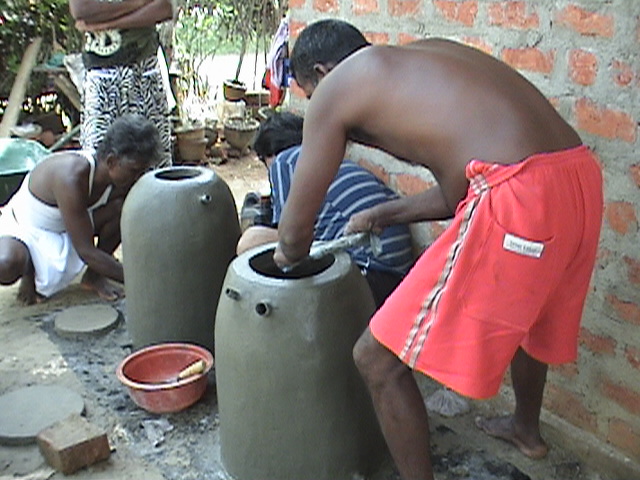Difference between revisions of "Small household ferrocement tanks (jars)"
| Line 7: | Line 7: | ||
==Suitable Conditions== | ==Suitable Conditions== | ||
| + | {{Climate_change | ||
| + | |heading1=Drought | ||
| + | |text1=- ''Effects of drought'': xxx <br> - ''Underlying causes of effects'': xxx <br> - ''To increase resiliency of WASH system'': xxx | ||
{{procontable | pro= | {{procontable | pro= | ||
| Line 14: | Line 17: | ||
- Cheap <br> | - Cheap <br> | ||
| con= | | con= | ||
| + | - The storage tank is the most expensive part of a roof rainwater system, and often they cannot hold enough water for whole dry season. Making bigger tanks is possible but more difficult and cost can be too high, which would make them not replicable on a larger scale. | ||
}} | }} | ||
Revision as of 20:05, 24 April 2012
The small ferro-cement tank or pitcher is a simple type of tank with several uses. Firstly it can be used as a triple septic chamber. It can also be used as an underground tank or domestically for water storage. It can be made in various different sizes as appropriate.
Suitable Conditions
{{Climate_change
|heading1=Drought
|text1=- Effects of drought: xxx
- Underlying causes of effects: xxx
- To increase resiliency of WASH system: xxx
| Advantages | Disadvantages/limitations |
|---|---|
| - Easy to construct. - Uses easily available materials. |
- The storage tank is the most expensive part of a roof rainwater system, and often they cannot hold enough water for whole dry season. Making bigger tanks is possible but more difficult and cost can be too high, which would make them not replicable on a larger scale. |
Construction, operations and maintenance
Construct a mesh of iron wires on an iron ring, for the base of the tank. Allow for extra length of wire to later support the sides of the tank. Spread a thick layer of mortar over the base and wait until it is semi-dry.
Then place a bag (the desired size of the tank) filled with sand or earth on top of the cement. Spread the first layer of mortar over the bag. Then raise the wires coming from the base and hook them onto a metal or plastic ring at the neck of the bag. Arrange horizontal wires across the bag.
Then spread the second layer of mortar over the wires. After about 20 hours, when the cement is dry, the bag can be emptied. A cement white-wash is brought onto the inside and outside of the tank. The tank must then be kept moist for 5 days so that the cement hardens.
In addition, a pipe or tap can be constructed at the bottom of the tank.
Cost
- Water jars from brick - US$78 per m3 storage (0.7 m3 for US$55)275.
- Water jars from ferrocement - US$50 - US$97 per m3 storage (3m3 for US$150, 0.5m3 for US$46.5276)
In Bolivia, the cost of construction of a tank of 200L is about 10$
Country Experiences
Bolivia
Reference manuals, videos, and links
- Video manual on how to construct a ferro-cement tank: http://www.blip.tv/file/2448844
Acknowledgements
- Buchner, Wolfgang E. EMAS Manual Water for Everybody.
- CARE Nederland, Desk Study Resilient WASH systems in drought prone areas. October 2010.

